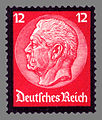Hindenburg medallion


The Hindenburg Medallion series of postage stamps was issued by the Deutsche Reichspost from October 1, 1932 and was valid until the surrender in 1945 , as the Reich Post Ministry decided, due to the war, in 1944 that all stamps would remain valid until further notice .
It was the second series of stamps, after the Reich President series of stamps, that had Reich President Paul von Hindenburg as a motif; In 1927, four charity stamps with his portrait had already appeared on his 80th birthday . The first day of the series was one day before his 85th birthday.
After his death, a partial edition appeared with a black border. As a special edition, this is not part of the definitive stamp series, but is listed in this article due to the similar motifs.
In addition to the permanent series Reich Chancellor Adolf Hitler , which was only introduced from August 1941 , the Hindenburg series offered almost the only possibility of franking mail at the pure postage value. From the year of issue 1936 at the latest, special stamps were issued almost exclusively as surcharge stamps with a considerable surcharge.
During the Second World War , the stamps in this series were also available with the respective country imprints in the occupied territories. The Soviet, British and US armed forces and their secret services also used individual values as templates for falsified propaganda .
After the surrender and the resumption of postal traffic , the remaining stamps were partially overprinted by the Allied occupying powers due to a lack of material and could thus continue to be used as franking for a short time; however, such uses are extremely rare.
Motif and printing process
The motif was identical in all denominations and showed the left half of Paul von Hindenburg's face in profile . The draft for the values came from the medalist Karl Goetz .
The duration series has been consistently in the printing process on coated paper with a Kammzähnung from 14:14 1/4 in size from 21.5 × 26 mm × 10 sheets of 10 stamps with two different watermark ( "Waffles", and from December 1933 "Swastikas") or as roll brands in rolls of 200, 250 each = 500, 500 and 1000 rolls.
A total of 44 different brands have appeared:
- October 1, 1932: 7 values (Michel numbers: 467–473)
- April to August 1933: 14 values (482–495)
- 1933 to 1936: 17 values: (512–528)
- September 4, 1935: 6 values: (548–553)
As a definitive series, this was also used on postal stationery as a value stamp for picture and postcards in the format 148: 105 mm. A total of 29 (P216 to P244) different card templates have been published, including five picture postcards with 1,416 different motifs and eight special postcards with 23 different motifs. Furthermore, in 1941 there was a reply postcard (2 × 15 Pfennig) for the " foreign workers " employed in the area of the Brussels Air District Command . From 1943 onwards, the remaining stocks were divided into question and answer sections and used as a domestic card in Germany with a new value imprint of 6 Pfennig. There was also a pneumatic tube card (55 pfennigs) for the two pneumatic tube networks in Berlin and Munich .
List of brands
German Empire
Definitive stamps
| image | description |
Values in pennies |
Issue date | MiNr. |
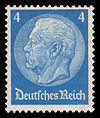
|
Issue I ( Watermark 2: Waffles )
|
4th | October 1, 1932 | 467 |

|
|
5 | October 1, 1932 | 468 |

|
|
12 | October 1, 1932 | 469 |

|
|
15th | October 1, 1932 | 470 |

|
|
25th | October 1, 1932 | 471 |

|
|
40 | October 1, 1932 | 472 |

|
|
50 | October 1, 1932 | 473 |

|
Issue II (Watermark 2: Waffles) | 3 | April 1933 | 482 |

|
4th | May 1933 | 483 | |

|
6th | April 1933 | 484 | |

|
8th | April 1933 | 485 | |

|
10 | May 1933 | 486 | |
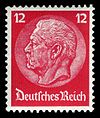
|
12 | April 1933 | 487 | |

|
15th | August 1933 | 488 | |

|
20th | May 1933 | 489 | |

|
30th | May 1933 | 490 | |

|
40 | August 1933 | 491 | |

|
50 | July 1933 | 492 | |

|
60 | May 1933 | 493 | |

|
80 | July 1933 | 494 | |

|
100 | July 1933 | 495 | |

|
Issue III (Watermark 4: Swastikas ) | 1 | 4th December 1933 | 512 |

|
3 | January 1934 | 513 | |

|
4th | February 1934 | 514 | |

|
5 | February 1934 | 515 | |

|
6th | February 1934 | 516 | |

|
8th | February 1934 | 517 | |

|
10 | February 1934 | 518 | |

|
12 | February 1934 | 519 | |

|
15th | April 1934 | 520 | |

|
20th | April 1934 | 521 | |

|
25th | April 1934 | 522 | |

|
30th | February 1934 | 523 | |

|
40 | February 1934 | 524 | |

|
50 | September 1934 | 525 | |

|
60 | May 1934 | 526 | |

|
80 | February 1936 | 527 | |

|
100 | September 1934 | 528 |
Overprints
For booklets and roll stamps
- August 5, 1933: Booklet sheet for booklet Michel-No .: 33. Watermark 2 with 5-, 6-, 8- and 12-pfennig stamps
- June 1934: No. 35 (donates to the victims of the labor!)
- End of August 1936/37: No. 36 (Supports the NS-Volkswohlfahrt !; Everything for Germany !; Germany a haven of peace!)
- Beginning of October 1937/39: No. 37 (Supports the NS-Volkswohlfahrt!)
- July 1939: from standard donor strip I, K21 from sheet (Supports the NS-Volkswohlfahrt !; Uses WHW postage stamps !; Save with the Postsparkasse !; Congratulations by sending jewelry sheet telegrams !; Join the NSV. !; Participate in postal checks!)
- October 1939: No. 38
- April 1940: No. 39 (Become a postal check participant !; Support the German Red Cross !; Congratulations through jewelry sheet telegrams!)
- 1939: from machine rolls, the brand rolls had 250 pairs of 4 + 6 pfennigs
- 1940 (February 1941): from standard donor strip II, K22 from sheet (supports the NS-Volkswohlfahrt!)
- 1940 (end of June 1941): from standard donor strip III, K22 from sheet (save with the postal savings bank!)
Postal stationery
As a definitive series, this was also used on postal stationery as a value stamp for picture and postcards in the format 148: 105 mm. A total of 29 (P216 to P244) different card templates have been published, including five picture postcards with 1,416 different motifs and eight special postcards with 23 different motifs. There was also a consumption issue and a pneumatic tube card (RP25).
| image | Value in pennies | Issue date | Postal stationery type | Printing process | particularities | Michel no. |
| 5 | 1932 | postcard | Letterpress | five-line sender's note | P 216 | |
| 5 | 1933 | postcard | Letterpress | five-line sender's note | P 217 | |
| 6th | 1933 | postcard | Letterpress | five-line sender's note | P 218 | |
| 15th | 1933 | World postcard | Letterpress | five-line sender's note | P 219 | |
| 6/6 | 1933 | Postcard with reply card | Letterpress | five-line sender's note | P 220 | |
| 6th | 1933 | Picture postcard | Gravure printing | 78 different motifs | P 221 | |
| 15th | 1933 | World postcard | Letterpress | Color change | P 222 | |
| 15/15 | 1933 | World postcard with reply card | Letterpress | Color change | P 223 | |
| 6th | November 4, 1933 | Special card | Letterpress | for the 450th birthday of Dr. Martin Luther | P 224 | |
| 5 | 1933/1934 | postcard | Letterpress | Sender's note only 3 pre-printed and 3 dot lines, "e" from postcard with a short line at the end | P 225 | |

|
6th | 1933/1934 | postcard | Letterpress (like P 225) | P 226 | |
| 15th | 1933/1934 | postcard | Letterpress (like P 225) | P 227 | ||
| 5/5 | 1933/1934 | Postcard with reply card | Letterpress (like P 225) | P 228 | ||
| 6/6 | 1933/1934 | Postcard with reply card | Letterpress (like P 225) | P 229 | ||
| 15/15 | 1933/1934 | Postcard with reply card | Letterpress (like P 225) | P 230 | ||
| 6th | 1934 | Picture postcard | Gravure printing | 9 different motifs | P 231 | |
| 6th | 1934 | Picture postcard | Gravure printing | 144 different motifs | P 232 | |
| 6th | 1934 | Picture postcard | Gravure printing | 36 different motifs | P 233 | |
| 5 | 1934 | Special postcard | Letterpress, the P225 provided with black mourning margin on the card edges | on the death of the Reich President von Hindenburg | P 234 | |
| 6th | 1934 | Special postcard | Letterpress, the P226 was provided with a black mourning border on the card edges | on the death of the Reich President von Hindenburg | P 235 | |
| 6th | 1934 | Picture postcard | Gravure printing | 1218 different motifs | P 236 | |
| 6th | October 21, 1936 | Special postcard | Gravure printing | for the laying of the foundation stone of the House of German Law in Munich | P 237 | |
| 5 | 1934 | Picture postcard for local traffic | Gravure printing | 9 different motifs | P 238 | |
| external image | 3 | January 7, 1939 | Special postcard | ?-pressure | day of the stamp | P 239 |
| 6th | July 18, 1939 | Special postcard | ?-pressure | to the KdF -Reichstagung in Hamburg, picture: KdF-Schiff Robert Ley | P 240 | |

|
6th | January 12, 1941 | Special postcard | Gravure printing | Day of the postage stamp ; Image: Messenger of the Wiener Klapperpost (here the map from the occupied territory of Luxembourg) | P 241 |

|
6th | January 12, 1941 | Special postcard | ?-pressure | Day of the postage stamp ; KdF collectors groups with eight different motifs of different types of troops: "In the struggle for freedom" | P 242 |
| 6th | April 20, 1941 | Special postcard | Value stamp: letterpress
|
Leader's birthday ; KdF collectors groups with eight different motifs of different types of troops: "With our flags there is victory" | P 243 | |

|
(15/15) / 6 | (1941) / 1943 | (Reply postcard) Consumption issue | Letterpress | 1941 reply postcard (15/15) intended for the foreign workers employed in the area of the Brussels Air District Command. From 1943 onwards, the remaining stocks were divided into question and answer sections and used as a domestic card in Germany with a new value imprint of 6 Pfennig. | (P1) P 244 |

|
55 | 1934 | Pneumatic postcard | light salmon-colored, 148: 105 mm | / 01 Pneumatic post in Berlin |
RP 25 |
Funeral stamps
After Hindenburg's death on August 2, 1934, a special edition was published on September 4 with the six most frequent postage values from the Hindenburg medallion with black border. In contrast to the permanent series values, these mourning stamps were only valid until December 31, 1935; their edition is not known.
Gift stamps
On the occasion of the 50th anniversary of the Berlin Philatelist Club of 1888 e. V. presented the Reichspost with a sheet with the 50-pfennig stamp (Michel no. 525). In contrast to the usual edge prints, the sheet margins were different with the text “16. January 1938. 50 Years of the Berlin Philatelic Club EV ” . The sheet was kept undivided in the archives of the association until it burned in the war.
German occupation issues
- Generalgouvernement : From December 1, 1939. For this purpose the stamps 513-514, 516-525 and 528 with horizontal, three-line overprint of the Reichsdruckerei Berlin Deutsche Post / OSTEN . The value overprint was in groschen and zloty (1 zloty = 100 groschen = 50 reichspfennig). These 13 values remained valid until September 30, 1940. See postage stamp issues for the Generalgouvernement 1939
- Alsace : From August 15, 1940 stamps 513-528 were provided with horizontal imprint Alsace . The 16 values were valid until December 31, 1941, after which only unprinted stamps were used.
- Lorraine : From August 21, 1940, the stamps 513-528 were provided with horizontal imprint Lorraine . The 16 values were valid until December 31, 1941, after which only unprinted stamps were used.
- Luxembourg : From October 1, 1940 stamps 513-528 were provided with a horizontal imprint Luxembourg . The 16 values were valid until December 31, 1941, after which only unprinted stamps were used.
Further use after the surrender of Germany
After the surrender and the resumption of mail traffic, the Allied occupying powers partly overprinted the remaining stamps and continued to use them due to a lack of material. With the Hindenburg medallion stamps, this was mainly possible in Saxony until around mid-August 1945 , but rarely.
Fake propaganda
see also: stamp forgery
Soviet forgeries for Germany
The Soviet forgeries are limited to forgeries of postcards, the so-called propaganda cards. Numerous different cards were produced, some of which are provided with the imprinted brand image for 6 Reichspfennig of the Hindenburg postal stamp series.
“On Hitler's orders, he went into the field healthy and with sound bones. So he returns: a cripple, mutilated, battered, a fragment of a person ...
What did this unfortunate man sacrifice his limbs, his health, his happiness for?
Was it all worth it?
GERMAN SOLDIER! As long as it's not too late - think about it. Let yourself be captured and the war is over for you. "
“This is the living space that the German soldiers found on the Eastern Front. 2 meters underground and a birch cross on the ground. Died far from home, spoiled ...
The snow covers the fallen like a shroud. The wind is whistling. The crows croak:
Krrr! Betr-r-rug! Betr-r-rug!
Hitler betrayed you, German soldiers! He promised you to take Moscow, but left you dead and crippled. On Christmas Eve, German women mourn Hitler's victims.
But you who are alive put an end to Hitler!
Put an end to the war! "
British counterfeits for Germany
As in the First World War, counterfeit war mails were produced in Great Britain for the German Empire during the Second World War. In this war, however, falsified propaganda were also produced.
First of all, forgeries of the 12 Reichspfennig value of the Hindenburg postage stamp series of the German Reich were produced in order to smuggle propaganda material into Germany similar to the allied US Americans. This was also done by aircraft dropping the letters franked with the counterfeit stamps over Germany. This was followed by the values of 3, 4, 6 and 8 Reichspfennig. This war post forgery is also known to be mint never hinged, as not all postage forgeries have been used up.
See also
- People who were honored on a German postage stamp during their lifetime
- In the 1927 stamp year , four charity issues were published for German emergency aid with a portrait of Hindenburg; The occasion was his 80th birthday. Although these are supplement stamps , the donation value is not stated on the stamps.
| image | description |
Values in pennies |
Issue date (1927) |
Date of Expiry | Edition | draft | MiNr. |

|
80th birthday of Reich President Paul von Hindenburg
|
8 (+7) | September 26th | July 31, 1928 | 4,801,295 | 403 | |
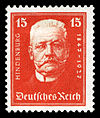
|
|
15 (+15) | September 26th | July 31, 1928 | 4,652,152 | 404 | |

|
|
25 (+25) | September 26th | July 31, 1928 | 714.259 | 405 | |
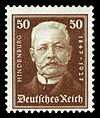
|
|
50 (+50) | September 26th | July 31, 1928 | 389,666 | 406 |
literature
-
Michel catalog , Schwaneberger Verlag GmbH, Munich
- Letters catalog Germany 1991, ISBN 3-87858-445-8
- Germany 1992/93, ISBN 3-87858-021-5
- Germany-Special 1999, ISBN 3-87858-132-7
- Postal stationery catalog Germany 1999, ISBN 3-87858-632-9
- Frank Arnau , Lexicon of Philately, 1972
Individual evidence
- ^ Postnachrichtenblatt - messages from the postal and telecommunications service; Ed .: Reichspostministerium, Volume 24, No. 3; Berlin, January 22, 1944
- ↑ a b c The two series I and II differ in the denominations and colors issued. At the III. Series, which is similar in terms of value and colors to the II., But has a few additional value steps, however, a different watermark paper was used.
- ↑ Michel-postal stationery catalog Germany 1999, pp. 152–155
- ↑ Greeting cards (five words) are possible, but normally used only with additional postage
- ↑ http://www.berliner-philatelisten-klub-1888.de/
- ↑ Michel Germany Special Catalog 1999; P. 362
- ↑ Michel Germany Catalog 2004/2005; P. 153




